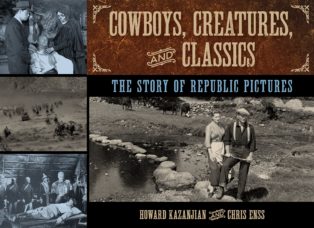Enter now to win a copy of
Cowboys, Creatures and Classics: The Story of Republic Pictures

One of the many chapter plays produced by Republic.
On August 17, 1958, Herbert Yates stormed out of a meeting with the principle shareholders of Republic Pictures and headed into the streets of New York. He was too mad to talk and hoped he could walk off some of his fury. Studio executives and stockholders had gathered in the city, 2,917 miles from the capital of the motion picture industry, to discuss the financial affairs of the company. The situation was dismal, and the blame for the current state of affairs was placed squarely in Yates’ lap. In fact, the frustrated executives accused the head of the studio of running the business for the private enrichment of himself and his family. Insulted by the claim, but unable to refute it, Yates slammed his fists on the boardroom table and stomped out of the room.
Abraham Meltzer, one of the studio’s backers who owned more than 540 shares of the company’s stock, contacted the state supreme court when Yates left and informed them of the board’s findings. Meltzer and the others were seeking an order to place Republic Pictures into receivership. The executives charged Yates with misappropriation of funds. According to Meltzer, Yates drew fifty thousand dollars a year for five years plus bonuses. That was in addition to his $150,000 a year salary. He further accused Yates of bringing Republic’s business to a standstill and trying to unload his shareholdings for a premium over the marketplace.
The studio executives also blamed the troubles Republic was encountering on Yates’ preoccupation with producing films to star Vera Ralston. The head of Republic Pictures had greenlit twenty films featuring the Czechoslovakian skater, and all but two were commercial failures. Yates had let his personal feelings for Ralston cloud his judgment, and the stockholders and the courts were compelled to make him answer for it.
A short twelve years prior to Yates’ confrontation with Meltzer and the other shareholders, the studio leader and Republic Pictures were the talk of the industry. Under Herbert Yates’ management, the company had brought comic book characters to life and sent them soaring through the skies. Daring cowboys thundered across the plains and brought evildoers to justice. Airplanes dropped down from the clouds and careened into buildings and bridges in spectacular explosions. Ticket buyers craving action and adventure found satisfaction in Republic Pictures’ productions. The New York Times proclaimed Yates’ studio the “little acorn that grew” and predicted the motion picture company would soon be an industry giant.
The February 2, 1941, edition of The New York Times read,
More than just a knack is required to successfully manufacture low-cost movies. Good management in the executive department and showmanship in the productive division are the prime requisites.
Republic has risen out of the talents of entertainer such as Autry, Canova, Rogers, and Burnette and on the strength of their perennial popularity which will endure for always.

To learn more about the many films Republic Pictures produced read
Cowboys, Creatures and Classics: The Story of Republic Pictures




